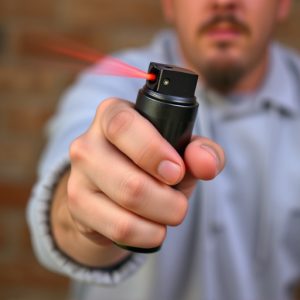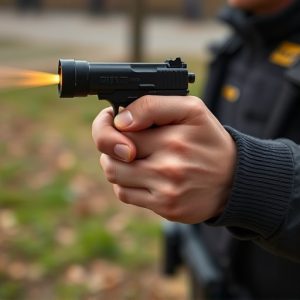Riot Control Innovations: Gel vs Stream Spray Performance Analysis
Riot control demands effective tools for managing large gatherings, with pepper spray gel and stream…….
Riot control demands effective tools for managing large gatherings, with pepper spray gel and stream offering distinct advantages. Gel's sticky consistency adheres to skin and clothing, temporarily disabling individuals, while stream provides a concentrated direct hit. The choice between them depends on crowd dynamics and tactical objectives. Pepper spray gel excels in de-escalation scenarios due to its superior adherence and prolonged effects, whereas stream spray's fine mist covers broader areas effectively in crowded settings. The optimal choice for riot control depends on law enforcement requirements, terrain, and anticipated crowd behavior.
In the realm of riot control, law enforcement agencies constantly seek effective tools to manage chaotic situations. This article explores two prominent options: traditional pepper spray gel and innovative stream spray technology. We delve into the properties, advantages, and differences between these substances, focusing on safety, effectiveness, and practicality. Understanding the nuances of Pepper Spray Gel vs Stream is crucial for navigating high-pressure scenarios, ensuring both public safety and officer efficacy.
- Understanding Riot Control: The Need for Effective Tools
- Introduction to Pepper Spray Gel: Properties and Advantages
- Stream Spray Technology: How Does it Differ and Perform?
- Comparing Gel vs Stream: Safety, Effectiveness, and Practicality
Understanding Riot Control: The Need for Effective Tools
Riot control is a complex challenge faced by law enforcement and security agencies worldwide. With large-scale gatherings and demonstrations often turning chaotic, there’s a pressing need for effective tools to manage and disperse crowds. In such situations, understanding crowd dynamics and employing suitable tactics become paramount.
One of the most widely used tools in riot control arsenal is pepper spray gel versus stream. Both serve different purposes. Pepper spray gel, with its sticky consistency, tends to stick to skin and clothing, causing immediate discomfort and temporarily disabling individuals. On the other hand, a stream of pepper spray is a concentrated, direct hit that can quickly neutralize threats. The choice between them depends on the nature of the crowd and tactical objectives, emphasizing the importance of selecting the right tool for optimal control and safety.
Introduction to Pepper Spray Gel: Properties and Advantages
Pepper spray gel is a specialized non-lethal weapon designed for riot control and crowd management, offering a unique approach compared to traditional pepper spray streams. This innovative formulation combines the powerful active ingredient capsaicin with a gel base, resulting in several key advantages. Unlike stream-based sprays that can be blown away by wind or require direct contact, pepper spray gel sticks to targets, ensuring its effectiveness even in challenging conditions.
One of the standout properties is its prolonged duration and visibility. The gel formula allows for a slower release of capsaicin, providing a longer-lasting sting and irritation, which is beneficial in persistent crowd scenarios. Additionally, the gel’s consistency makes it easier to target specific areas, such as eyes and respiratory tracts, maximizing impact while minimizing off-target effects. This precision is especially valuable in situations where crowd control requires de-escalation tactics.
Stream Spray Technology: How Does it Differ and Perform?
Stream spray technology represents a significant advancement in riot control compared to traditional pepper spray gel. While both aim to incapacitate individuals through irritant agents, stream spray delivers a fine mist of liquid at high velocity, covering a larger area and providing more even distribution of the active ingredient. This makes it highly effective in crowded spaces where direct contact with skin or eyes may be challenging.
In contrast, pepper spray gel is thicker and stickier, designed to cling to surfaces and directly irritate mucous membranes. While it can be potent, its effects are more localized and may not achieve the same level of widespread disruption as stream spray. Moreover, the sticky nature of gel can lead to easier washing off by individuals targeted, reducing its effectiveness over time. Stream spray’s aerodynamic design ensures sustained impact, making it a preferred choice for law enforcement in high-risk situations requiring swift and comprehensive crowd control.
Comparing Gel vs Stream: Safety, Effectiveness, and Practicality
When it comes to riot control, Pepper Spray Gel and Stream offer distinct advantages and considerations. One key difference lies in their application methods; gel is typically applied through a handheld device, while stream sprays are often launched from longer-range weapons. This tactical distinction significantly impacts practicality during chaotic situations.
In terms of safety, pepper spray gel is generally considered less harmful for bystanders due to its localized effect and slower release mechanism. Stream sprays, on the other hand, can reach farther distances, potentially affecting non-target areas. Effectiveness-wise, both have proven successful in disrupting crowds, but gel might offer better control due to its ability to stick to skin and clothing. However, stream sprays provide a more comprehensive coverage area, making them suitable for open spaces. The choice between the two ultimately depends on specific law enforcement needs, terrain, and crowd behavior anticipated at the scene of operation.
In comparing pepper spray gel and stream technology, it’s evident that both have unique properties and advantages in riot control. While gel offers better stickiness, visibility, and a longer-lasting effect, stream spray distinguishes itself with its precision, rapid dispersion, and reduced risk of inhalation. The choice between the two largely depends on specific tactical needs, environmental factors, and safety considerations. As law enforcement agencies continue to seek effective tools for crowd control, understanding these differences is crucial in ensuring both public safety and the efficient management of high-pressure situations. Thus, the optimal selection lies in balancing practicality and effectiveness, ultimately aiming to de-escalate conflicts peacefully and securely.


